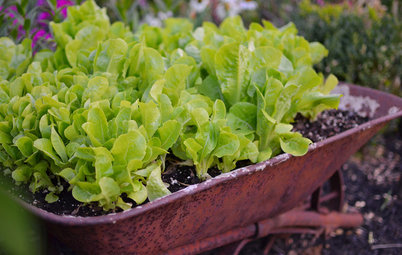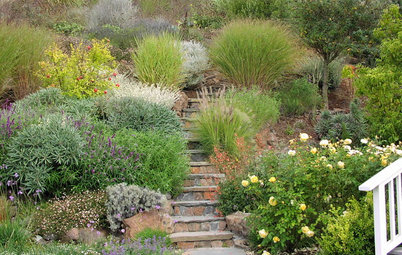LOOKING for: sodium in canned foods
marricgardens
My DH has recently been diagnosed a diabetic and he also has high blood pressure. I was thinking of canning our vegies. I have read on different sites you do not need to add salt when canning them. Salt is only added for flavor. I would also like to do some pickling but was concerned about the amount of sodium in the pickling salt. Most recipes call for 1/4-1/2 c. of salt. Do you think that would add a lot of sodium to the pickled foods? Marg
Browse Gardening and Landscaping Stories on Houzz See all Stories
Gardening Guides
Yes, You Can Grow Food in a Shady Yard
By Brian Barth
Your shady garden doesn’t have to be forever barren. Berries, herbs and other shade-loving plants can produce a delicious bounty
Full Story
Edible Gardens
Food and Community Thrive in a U.K. Allotment Garden
Get a peek at a rented garden plot in England where edibles and flowers mix and local residents can mingle
Full Story
Gardening Guides
Yes, You Can Grow an Edible Garden on a Hot, Dry Site
By Brian Barth
Difficult garden spots don’t need to deter you from planting trees, herbs and other delicious food plants
Full Story



















You can pressure can veggies w/o salt. Sometimes there are textural changes without it, though. I'd recommend doing a test batch before going whole hog. Have you pressure canned before?
Commercially frozen vegetables can be had w/o salt, but you do have to read each package as it varies from one brand to another. Salt is added to preserve the color. Frozen vegetables with seasonings and sauces tend to be very salty. Unsalted veggies should be less than 20 mg/ serving which accounts for what's there naturally. And, of course, home frozen veggies can be any way you like them.
Now, re pickles: Pickling salt is about the same mg/quarter teaspoon as table salt (590 mg). Some brands of pickling salt may vary. Although you are combining the salt with water to make a brine (and you won't be consuming the salt that stays in the brine) still the point of pickling is to have the saline brine and the vegetable reach a saltiness equilibrium so the pickle is just as salty as the brine when the pickling process is complete. And in this instance, salt is not there for cosmetic, or even solely for flavor, purposes, it's there for functional food safety reasons. Otherwise your cukes would be a slimy, disgusting, foul mess instead of nice dill chips.
The other issue is that it is complicated to calculate the mg/Na (sodium) in home-made brined pickles. Food companies can simply pay to have samples of the product tested to make the labels.
Here's a rough way to calculate it for home-made pickles:You could take the total amount of salt added in the recipe (figure 1/4 c is four tablespoons, which is twelve teaspoons then times whatever the package of brining salt says, in this case we'll use 590 mg per quarter teaspoon or 48 times that 590 or 28,320 mg of sodium in the entire batch, counting both the brine and the pickles, by volume. ) Then you have to figure out the volume the pickle piece occupies relative to the entire volume and divide that into the 28,320 mg to get the amount of sodium (theoretically) in each piece. More or less.
Pickles are a tasty little condiment, so even though my DH is on an very low sodium diet we still eat them. But in very small quantities.
However, I also buy some commercial pickles because it's easier than doing all this calculations. There is surprising difference among the brands, Vlasic is pretty salty; my store brands are all over the place, but there's one brand that seems to be consistently the lowest among the various types of pickles. It's Mt Something Olive? Ida?(I am not at home right now, but could check for you. It may be a regional one in the Northeast.)
I "allow" up to 75 mg of sodium for condiments per day out of 1,000 mg/day budget, which is very generous. The dietician thought it would be better to only allow 40 mg for the condiments. But we eat very little prepared food, so we have more room the add in tasty extras.
Bread is the hardest thing to work with because, there again, salt is both for taste and also for function in managing the development of the dough.
How low are you trying to go in mg/day? Most people here in the US eat 4,000-5,000 mg. It's recommended that we lower that to 2,000 for good health, even though 1,500 would be best for people with normal health. A cheesburger can easily exceed 1,750 mg/NA - along with all its other less-than-great things.
Lowering sodium is tough but it can be done. Takes about 6 weeks to get accustomed to it.
Don't use salt "substitutes" unless your Dr. specifically OKs them. They are loaded with potassium salts instead of sodium salts, which can be a problem for some people on low-salt diets.
I can make some other suggestions about managing the food prep for a low-salt diet, if needed. I really worked at it at first. Now it's second nature.
HTH
L.
I am cooking for my sister who is diabetic with potassium that must be controlled and sodium is a no-no. I have heard that I can soak potatoes to remove potassium. Can't seem to get a handle on her requirements. Low carb (meat and salads) would seem to be the answer. My sister loves food. Potatoes, bread and butter, macaroni any way. I have found that canned foods have too much sodium so I buy frozen vegetables. I am finding cooking very difficult and frustrating. I will appreciate any suggestions anyone can offer.
Here's a website that lists foods both high and low in potassium, along with a few related links.http://www.davita.com/kidney-disease/diet-and-nutrition/diet%20basics/potassium-and-chronic-kidney-disease/e/5308
Hope this helps.